#Income Tax Form 16
Explore tagged Tumblr posts
Text
Stock and Share Market News, Economy and Finance News, Sensex, Nifty, Global Market, NSE, BSE Live IPO News
By Market Capitalisation.Net Sales.Net Profit.Total Assets.Excise.Other Income.Raw Materials.Power & Fuel.Employee Cost.PBDIT.Interest.Tax.EPS.Investments.Sundry Debtors.Cash/Bank.Inventory.Debt.Contingent Liabilities. Screen Crit AbrasivesAerospace & DefenceAgricultureAir ConditionersAirlinesAluminium & Aluminium ProductsAmusement Parks/Recreation/ClubAquacultureAuto AncillariesAuto…
View On WordPress
#Automatic Income Tax Calculator in Excel#BSE#Economy#Finance#global#Income Tax#Income Tax Arrears Relief Calculator U/s 89(1)#Income Tax Form 10E#Income Tax Form 16#Income Tax Form 16 Part B#Income Tax Preparation software in Excel#IPO#Live#market#News#Nifty#NSE#Sensex#Share#Stock
0 notes
Text
Access Denied
Access Denied You don’t have permission to access ” on this server. Reference #18.c7fdd417.1719883386.1b143577 Source link
View On WordPress
#Access#Automatic Income Tax Calculator in Excel#denied#Income Tax#Income Tax Arrears Relief Calculator U/s 89(1)#Income Tax Form 10E#Income Tax Form 16#Income Tax Form 16 Part B#Income Tax Preparation software in Excel
0 notes
Text
What Happens If Your Employer Doesn’t Give You Form 16?
“Wondering if Form 16 is necessary for ITR filing? Learn how to file your Income Tax Return without Form 16 using Form 26AS, AIS, and other documents. Get step-by-step guidance, latest updates for 2023, and expert tips to ensure hassle-free tax compliance. Read now!” Filing Income Tax Returns (ITR) is a crucial annual activity for every taxpayer in India. It ensures compliance with tax laws and…
#AIS and TIS for ITR#file ITR without Form 16#Form 16 and Income Tax Return#Form 16 deadline#Form 16 for ITR filing#Form 16 vs Form 26AS#is Form 16 mandatory for ITR#ITR filing process#tax filing without Form 16#what to do if no Form 16
0 notes
Video
youtube
How to File ITR1 with 2 Form16|Income & Tax Computation New Tax Regime| ...
#youtube#2 form 16#how to file itr1 ay 24-25#how to file itr1 in case of 2 form 16#itr1 ay 2024-25#how to compute income tax as per new tax regime#new tax regime
0 notes
Text
FAQs on FORM 16
FORM 16, an essential document under the Income Tax Act of 1961, holds significant importance for salaried individuals. To demystify the complexities surrounding FORM 16, we delve into the top 10 frequently asked questions (FAQs) to provide clarity and understanding. 1. What is FORM 16 and its significance? FORM 16 is a certificate issued by employers to employees, detailing the TDS deducted…

View On WordPress
#employers#errors rectification#FAQs#finance#financial year#FORM 16#income tax#Income Tax Act 1961#multiple employers#online download#PART A#proof of income#reconciliation#salary income#tax#tax deductions#tax liabilities#tax-planning#taxes#TDS
0 notes
Text
Company registration in India
RAAAS is a Chartered Accountant firm based in India that provides Company registration in India. The firm has a team of experienced professionals who can help you to register your company quickly and easily.
There are many benefits to registering your company in India. India is a growing economy with a large population, which provides businesses with a large potential customer base. India also has a number of tax and other benefits for businesses.
Here are some of the steps involved in registering a company in India:
Choose a company name. The company name must be unique and not already in use by another company. You can check the availability of company names on the Ministry of Corporate Affairs (MCA) website. Obtain a Director Identification Number (DIN). A DIN is a unique number that is assigned to each director of a company. You can apply for a DIN on the MCA website. Obtain a Digital Signature Certificate (DSC). A DSC is a digital certificate that is used to authenticate electronic documents. You can apply for a DSC from a licensed Certifying Authority. Draft the Memorandum of Association (MOA) and Articles of Association (AOA). The MOA and AOA are the two main legal documents that define the company's constitution. Apply for Company registration in India. You can apply for Company registration in India on the MCA website. You will need to submit the MOA, AOA, and other required documents. Pay the registration fee. The registration fee depends on the type of company you are registering. Once you have completed all of the above steps, your company will be registered and you will receive a Certificate of Incorporation from the MCA.
RAAAS can help you with all of the steps involved in registering your company in India. The firm's team of professionals can help you to choose a company name, obtain a DIN and DSC, draft the MOA and AOA, and apply for Company registration in India. RAAAS can also help you to pay the registration fee and ensure that your company is registered in compliance with all applicable laws and regulations.
If you are planning to register a company in India, contact RAAAS today for a free consultation.
Benefits of using RAAAS's Company registration in India There are many benefits to using RAAAS's Company registration in India, including:
Expertise: RAAAS has a team of experienced professionals who can help you to register your company quickly and easily. Convenience: RAAAS can handle all of the steps involved in company registration on your behalf. Affordability: RAAAS's company registration services are affordable. Peace of mind: RAAAS can help you to ensure that your company is registered in compliance with all applicable laws and regulations. If you are looking for a reliable and affordable Company registration in India service provider, RAAAS is a great option to consider.
#cashflow#charted accountant#form 16#msme registration#company registration#gst registration#tax services#gst#income tax#tax
0 notes
Text
PREQUELLE VOCABULARY
1. Feudalism – A hierarchical system where land was exchanged for military service and labor.
2. Serf – A peasant bound to a lord’s land, providing labor in exchange for protection.
3. Manor – A self-sufficient estate controlled by a lord in medieval Europe.
4. Chivalry – A medieval knightly code of conduct emphasizing honor and bravery.
5. Guild – A medieval association of craftsmen or merchants controlling trade standards.
6. Bubonic Plague – A deadly bacterial infection spread by fleas, causing the Black Death.
7. Flagellants – Religious zealots who self-punished to atone for sins during the plague.
8. Pneumonic Plague – A form of the Black Death that infected the lungs and spread via air.
9. Pandemic – A widespread outbreak of a disease across multiple regions or continents.
10. Quarantine – Isolation of individuals to prevent the spread of disease.
11. Inquisition – A Church-led tribunal that investigated and punished heresy.
12. Heresy – Beliefs or practices that went against official Church doctrine.
13. Auto-da-fé – A public ceremony where heretics were punished, often by execution.
14. Torture – The use of pain to extract confessions or punish accused heretics.
15. Excommunication – Official expulsion from the Church, cutting off religious rights.
16. Dominican Order – A Catholic order heavily involved in the Inquisition’s trials.
17. Reconquista – The Christian effort to reclaim Spain from Muslim rule.
18. Papal Bull – An official decree issued by the Pope.
19. Moors – Muslim inhabitants of medieval Spain and North Africa.
20. Doom Painting – Medieval artwork depicting the Last Judgment and the fate of sinners.
21. Monastery – A religious community where monks lived, worked, and prayed.
22. Abbey – A monastery or convent under the authority of an abbot or abbess.
23. Clergy – The body of people ordained for religious duties, including priests and bishops.
24. Pope – The leader of the Roman Catholic Church and the Bishop of Rome.
25. Cardinal – A high-ranking church official who advises the Pope and elects new Popes.
26. Bishop – A church official who oversees a diocese and has authority over priests.
27. Priest – A church leader who conducts religious services and administers sacraments.
28. Cathedral – A large, important church that serves as a bishop’s seat.
29. Gothic Architecture – A medieval style of church building featuring pointed arches and stained glass.
30. Tithe – A mandatory church tax, typically 10% of a person’s income.
31. Papal States – Territories in Italy controlled directly by the Pope.
32. Indulgence – A pardon sold by the Church to reduce punishment for sins.
33. Relic – A sacred object, often associated with saints, believed to have holy power.
34. Mass – The central worship service of the Catholic Church.
35. Sacrament – A religious rite, such as baptism or communion, considered sacred.
36. Monasticism – A way of life in which individuals dedicate themselves to religious service.
37. Holy Roman Empire – A multi-territorial empire in medieval Europe closely tied to the Church.
38. Canon Law – The legal system governing the Catholic Church.
39. Crusades – A series of religious wars sanctioned by the Pope to reclaim the Holy Land.
40. Simony – The buying or selling of church positions, a common practice in medieval times.
41. Yersinia pestis – The bacterium responsible for the Black Plague.
42. Plague Doctor – A physician who treated plague victims, often wearing a beaked mask.
43. Miasma Theory – The belief that diseases spread through “bad air” rather than germs.
44. Pestilence – A term for a deadly and widespread disease, often used for the plague.
45. Death Cart – A wagon used to collect and transport plague victims to mass graves.
46. Mass Grave – A large burial site for multiple plague victims.
47. Ring Around the Rosie – A nursery rhyme believed to reference the Black Plague.
48. Contagion – The transmission of disease through direct or indirect contact.
49. Plague Pit – A deep trench where bodies of plague victims were buried.
50. Hygiene – Poor sanitation in medieval cities contributed to the rapid spread of disease.
51. Trial by Ordeal – A medieval practice where accused heretics underwent painful tests to prove innocence.
52. Witch Hunt – The pursuit and persecution of individuals accused of heresy or witchcraft.
53. Edict of Faith – A public announcement by the Inquisition urging people to report heretics.
54. Relapsed Heretic – Someone accused of heresy more than once, often punished by execution.
55. Grand Inquisitor – The head of the Inquisition in a given region, overseeing trials and punishments.
56. Iron Maiden – A spiked coffin-like torture device used to impale victims.
57. Rack – A device that stretched the body, dislocating joints as a form of torture.
58. Thumbscrew – A device that crushed fingers or toes to extract confessions.
59. Heretic’s Fork – A metal rod placed between the chin and chest to prevent speech or rest.
60. The Pit – A deep, dark hole where prisoners were left to starve in isolation and despair.
#serene sun nocontext#the band ghost#serene sun spice time#serene sun mutuals#ghost band#the band ghost x reader#nameless ghouls x reader#nameless ghouls#serene sun writes#ghost band fic#prequelle
25 notes
·
View notes
Text
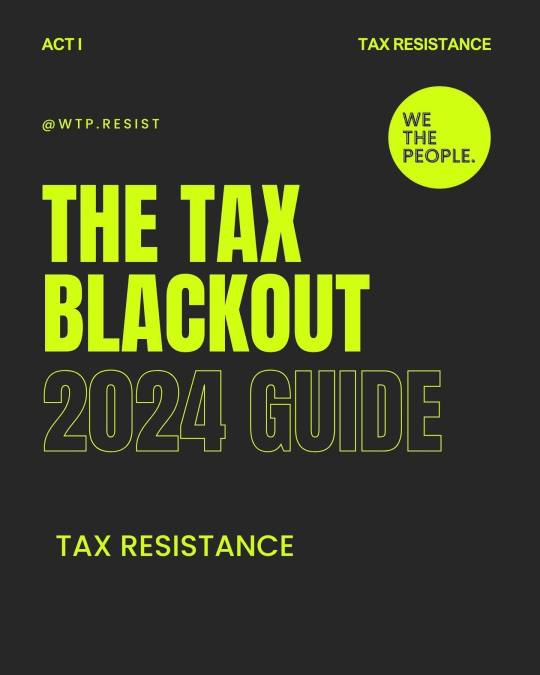
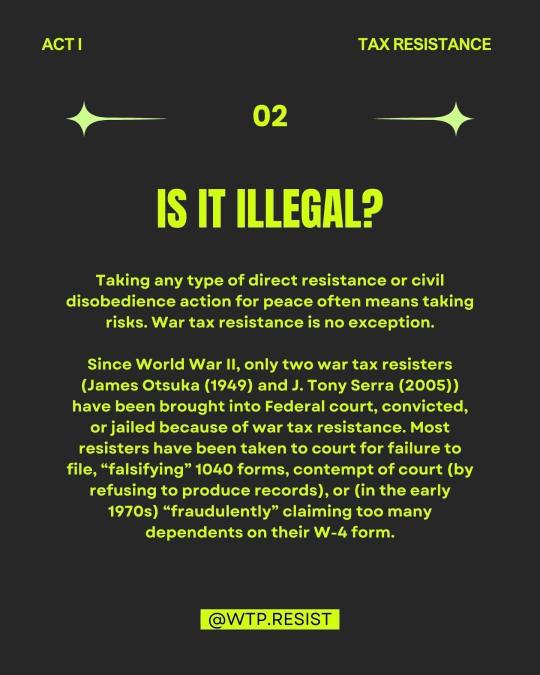
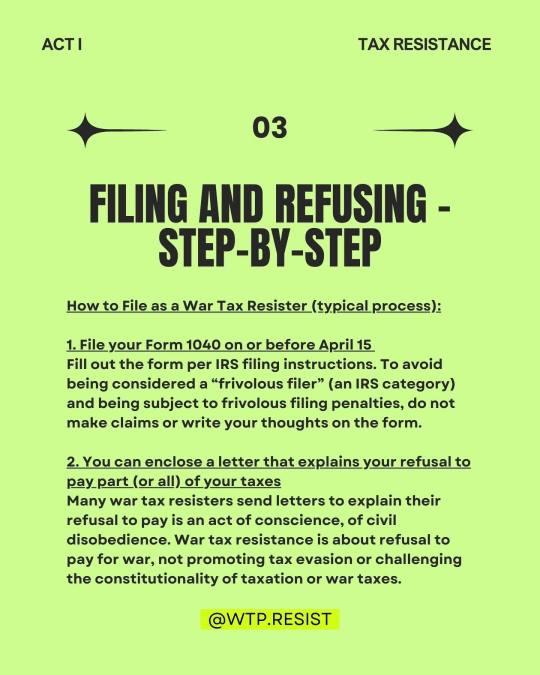
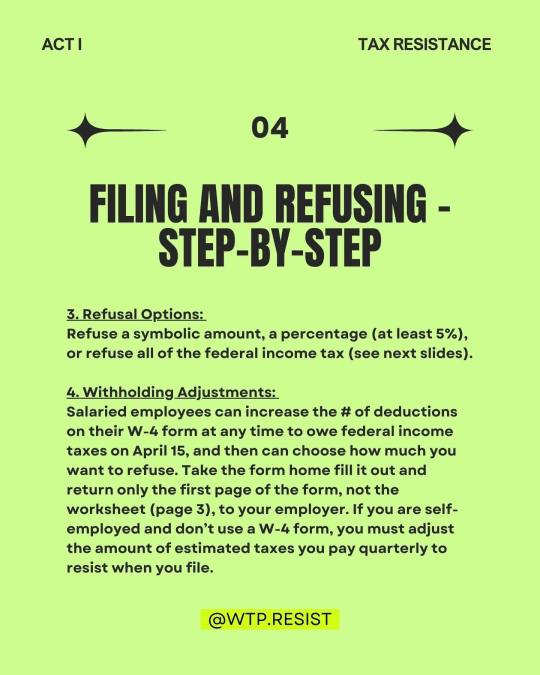
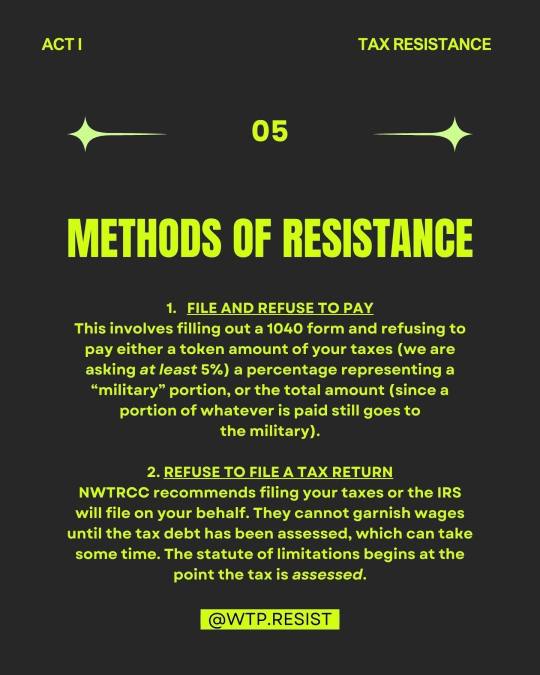
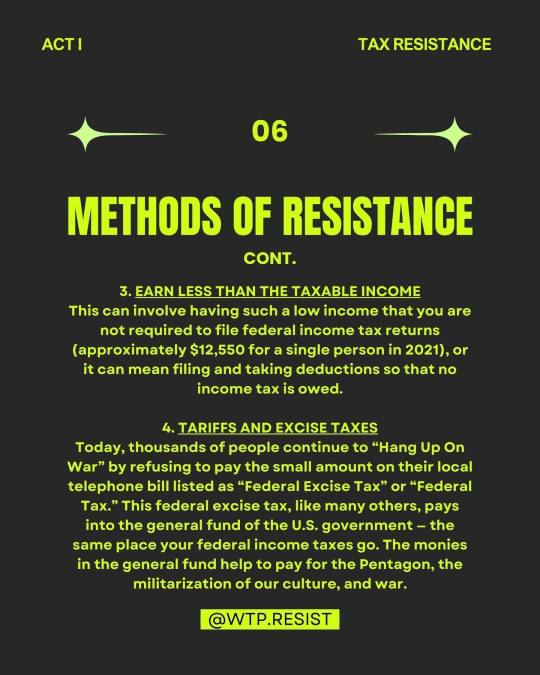
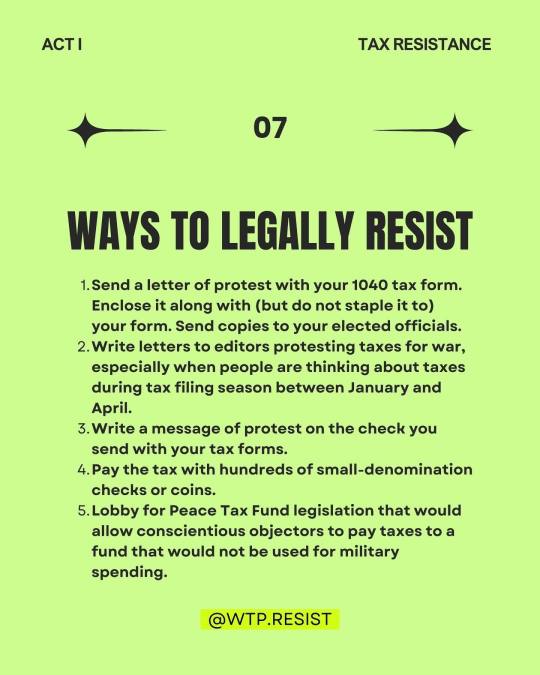

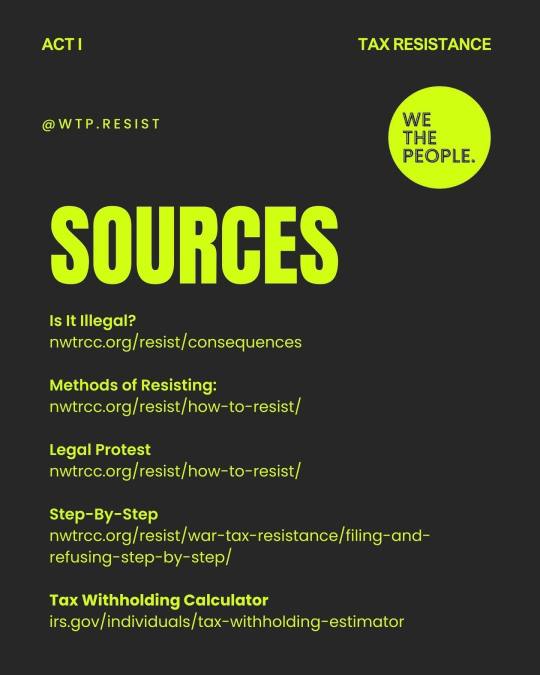
from @/wtp.resist on Instagram:
Tax Day is Monday, April 15th... just 4 days away ‼️ 💸 ⠀⠀⠀⠀⠀⠀⠀⠀⠀ Follow this outline for an easy-to-understand guide on how to participate in war tax resistance this year. If you are unable to participate in war tax resistance but still wish to legally protest, please see slide #7. We want to encourage people to think big and act with courage, but we also understand not everyone can resist in the same way, so we wanted to provide several measures of resistance and resistance support in our Act I — War Tax Resistance — Tax Blackout 2024 Campaign. ⠀⠀⠀⠀⠀⠀⠀⠀⠀ Our #TaxBlackout goal is 50 million people... with 16% of the U.S. population participating with at least 5% being redirected to vetted emergency relief in Gaza, Washington D.C. will receive a message loud and clear: ⠀⠀⠀⠀⠀⠀⠀⠀⠀ We will not fund Genocide and Imperialism!
transcript of all slides under the cut
slide 1: Act I Tax Resistance
by @ WTP.resist / We the People
The Tax Blackout 2024 Guide
Tax Resistance
slide 2: Is It Illegal?
Taking any type of direct resistance or civil disobedience action for peace often means taking risks. War tax resistance is no exception.
Since World War I, only two war tax resisters (James Otsuka (1949) and J. Tony Serra (2005)) have been brought into Federal court, convicted, or jailed because of war tax resistance. Most resisters have been taken to court for failure to file, "falsifying" 1040 forms, contempt of court (by refusing to produce records), or (in the early 1970s) "fraudulently" claiming too many dependents on their W-4 form.
slide 3: Filing And Refusing - Step-By-Step
How to File as a War Tax Resister (typical process):
1. File your Form 1040 on or before April 15
Fill out the form per IRS filing instructions. To avoid being considered a "frivolous filer" (an IRS category) and being subject to frivolous filing penalties, do not make claims or write your thoughts on the form.
2. You can enclose a letter that explains your refusal to pay part (or all) of your taxes
Many war tax resisters send letters to explain their refusal to pay is an act of conscience, of civil disobedience. War tax resistance is about refusal to pay for war, not promoting tax evasion or challenging the constitutionality of taxation or war taxes.
slide 4: Filing And Refusing - Step-By-Step
3. Refusal Options:
Refuse a symbolic amount, a percentage (at least 5%), or refuse all of the federal income tax (see next slides).
4. Withholding Adjustments:
Salaried employees can increase the # of deductions on their W-4 form at any time to owe federal income taxes on April 15, and then can choose how much you want to refuse. Take the form home fill it out and return only the first page of the form, not the worksheet (page 3), to your employer. If you are self-employed and don't use a W-4 form, you must adjust the amount of estimated taxes you pay quarterly to resist when you file.
slide 5: Methods Of Resistance
1. File and Refuse to Pay
This involves filling out a 1040 form and refusing to pay either a token amount of your taxes (we are asking at least 5%) a percentage representing a "military" portion, or the total amount (since a portion of whatever is paid still goes to the military).
2. Refuse to File a Tax Return
NWTRCC recommends filing your taxes or the IRS will file on your behalf. They cannot garnish wages until the tax debt has been assessed, which can take some time. The statute of limitations begins at the point the tax is assessed.
slide 6: Methods Of Resistance Continued
3. Earn Less Than The Taxable Income
This can involve having such a low income that you are not required to file federal income tax returns (approximately $12,550 for a single person in 2021), or it can mean filing and taking deductions so that no income tax is owed.
4. Tariffs and Excise Taxes
Today, thousands of people continue to "Hang Up On War" by refusing to pay the small amount on their local telephone bill listed as "Federal Excise Tax" or "Federal Tax." This federal excise tax, like many others, pays into the general fund of the U.S. government - the same place your federal income taxes go. The monies in the general fund help to pay for the Pentagon, the militarization of our culture, and war.
slide 7: Ways To Legally Resist
Send a letter of protest with your 1040 tax form. Enclose it along with (but do not staple it to) your form. Send copies to your elected officials.
Write letters to editors protesting taxes for war, especially when people are thinking about taxes during tax filing season between January and April.
Write a message of protest on the check you send with your tax forms.
Pay the tax with hundreds of small-denomination checks or coins.
Lobby for Peace Tax Fund legislation that would allow conscientious objectors to pay taxes to a fund that would not be used for military spending.
slide 8: Remember!
If at any time you have questions about risks and how to prepare:
War Tax Resistance Counselor: NWTRCC.org/resist/contacts-counselors
War Tax Resistance Hotline: TEL: +1-800-269-7464
slide 9: Sources
Is It Illegal?
nwtrcc.org/resist/consequences
Methods of Resisting:
nwtrcc.org/resist/how-to-resist/
Legal Protest
nwtrcc.org/resist/how-to-resist/
Step-By-Step
nwtrcc.org/resist/war-tax-resistance/filing-and-refusing-step-by-step/
Tax Withholding Calculator
irs.gov/individuals/tax-withholding-estimator
#tax resistance#war tax resistance#we the people#free palestine#palestine#EndIsraelsGenocide#tax blackout 2024#anti imperialism
29 notes
·
View notes
Text
Why Payroll Outsourcing in Delhi is Essential for Business Efficiency

Streamline Your Business with Payroll Outsourcing in Delhi
As businesses expand and compliance regulations become more demanding, many organizations are now turning to payroll outsourcing in Delhi to simplify their internal operations. Managing payroll in-house can be tedious, especially when dealing with frequent legal updates, tax deductions, and employee benefits. Outsourcing this function not only ensures accuracy but also provides companies the freedom to focus on core business activities.
What is Payroll Outsourcing?
Payroll outsourcing is the process of hiring an external service provider to manage a company's entire payroll system. This includes calculating employee salaries, processing tax filings, managing provident fund (PF) and employee state insurance (ESI) contributions, generating payslips, and ensuring legal compliance. For businesses in Delhi—a city teeming with startups, SMEs, and large enterprises—this approach has become a practical necessity.
Benefits of Payroll Outsourcing
1. Cost and Time Efficiency Managing payroll internally can consume significant time and resources. With outsourcing, companies save on the cost of hiring specialized staff or purchasing expensive payroll software. It also eliminates the need for constant training to stay up-to-date with changing laws.
2. Regulatory Compliance Indian payroll laws are complex and ever-evolving. From income tax rules to statutory deductions like PF, ESI, and gratuity, compliance is critical to avoid penalties. A payroll outsourcing provider in Delhi ensures all calculations and filings are handled accurately and on time.
3. Enhanced Accuracy Manual payroll processing can lead to errors in salary calculations or tax filings. With automated systems and expert oversight, outsourced payroll services offer greater accuracy and reliability, reducing the chances of employee dissatisfaction or legal issues.
4. Data Security and Confidentiality Reputable payroll outsourcing firms use secure, cloud-based systems with encryption to protect sensitive employee data. This minimizes the risk of data breaches and ensures confidentiality is maintained at all times.
5. Scalability and Flexibility As your workforce grows or contracts, outsourcing partners can easily scale their services to match your needs. Whether you’re hiring 10 or 100 new employees, your payroll operations remain smooth and efficient.
Services Included in Payroll Outsourcing
Most payroll outsourcing providers in Delhi offer comprehensive solutions that include:
Monthly salary processing and disbursement
Payslip generation and distribution
Tax deductions and filings (TDS, PF, ESI, etc.)
Year-end tax form preparation (Form 16)
Compliance with labor laws and statutory reporting
Attendance and leave management integration
Reimbursement and bonus management
Employee helpdesk support for payroll queries
Advanced service providers may also offer integration with HR software, mobile apps for employees, and dashboards for real-time payroll analytics.
Why Delhi-Based Companies Should Consider Payroll Outsourcing
Delhi is a highly competitive and regulatory-sensitive business environment. Companies in this region must be agile and compliant while controlling costs. Payroll outsourcing is especially beneficial here because local providers have expertise in regional labor rules, state-specific regulations, and offer fast turnaround times for urgent payroll processing needs.
Additionally, Delhi is home to a wide pool of professional payroll service providers who offer tailored solutions for different industries—from IT and education to manufacturing and healthcare.
Choosing the Right Payroll Partner
Before selecting a payroll outsourcing company in Delhi, consider the following:
Experience and Reputation: Look for a provider with proven experience and client testimonials.
Technology Platform: Ensure they use a secure, modern payroll system.
Compliance Knowledge: They should stay updated with the latest changes in tax and labor laws.
Customization Options: Your business may have unique payroll structures or benefits.
Customer Support: Timely and responsive communication is essential for resolving issues quickly.
Final Thoughts
In a fast-moving market like Delhi, where talent retention, compliance, and cost control are key concerns, outsourcing payroll can offer a significant competitive advantage. It streamlines processes, ensures accuracy, and reduces operational stress—allowing companies to concentrate on strategic goals.
Whether you're a small business owner or the HR head of a growing enterprise, payroll outsourcing in Delhi could be the smartest step you take this year toward efficiency and peace of mind.
2 notes
·
View notes
Text
Access Denied
Access Denied You don’t have permission to access ” on this server. Reference #18.c7fdd417.1719883386.1b143577 Source link
View On WordPress
#Access#Automatic Income Tax Calculator in Excel#denied#Income Tax#Income Tax Arrears Relief Calculator U/s 89(1)#Income Tax Form 10E#Income Tax Form 16#Income Tax Form 16 Part B#Income Tax Preparation software in Excel
0 notes
Text
Access Denied
Access Denied You don’t have permission to access ” on this server. Reference #18.c7fdd417.1719879703.1ae7726b Source link
View On WordPress
#Access#Automatic Income Tax Calculator in Excel#denied#Income Tax#Income Tax Arrears Relief Calculator U/s 89(1)#Income Tax Form 10E#Income Tax Form 16#Income Tax Form 16 Part B#Income Tax Preparation software in Excel
0 notes
Text
Paul V. Fontelo at Roll Call:
Rep. Bill Pascrell Jr., a New Jersey Democrat first elected to the House in 1996, died on Wednesday, his office announced on X. He was 87 and would have been the oldest member of the House if reelected in November. “Bill fought to his last breath to return to the job he cherished and the people he loved,” the post said. “Bill lived his entire life in Paterson and had an unwavering love for the city he grew up in and served. He is now at peace after a life time devoted to our great nation America.” A veteran of New Jersey’s brand of politics who dominated his home Passaic County, Pascrell was known for his pugnacious demeanor in promoting tax enforcement and ensuring “tax fairness” for all income levels. To achieve that, “everybody’s got to pull on the rope the same,” he said.
An Army veteran and one-time semi-professional baseball player, Pascrell was a teenager when his uncle took him to his first ward meeting in the city of Paterson, then a factory town with a thriving textile business. The rough-and-tumble political arena left an impression on Pascrell. “There’s a lot of fist fights … I’m gonna like this,” he recalled in an interview. “I did. I stayed with it since I was 16 years old.” While he saw far fewer physical melees between parties in Congress, Pascrell said he stuck by the lessons he learned from his first exposure to politics. “See it through or else don’t start it,” he said. And when you are in a fight, “never yield.” In the 118th Congress, Pascrell was the top Democrat on the Ways and Means Oversight Subcommittee, having previously spent more than two years as the panel’s chairman. He and fellow Ways and Means Democrats scored several victories in the final months of the previous Congress, including enacting a major tax and social spending budget reconciliation law and, after years of legal battles, acquiring six years of former President Donald Trump’s tax returns in the lame duck session after the 2022.
Pascrell waged a long campaign to tax “carried interest,” a form of compensation for investment fund managers that is not taxed like ordinary income, a situation he called a loophole that allows rich individuals to avoid fair taxation. He repeatedly introduced legislation to change inheritance rules as well. His bill on the so-called stepped-up basis would have changed existing tax law so that when someone dies and passes on property, the inheritor would pay capital gains taxes based on the fair market rate of the inherited assets, with a few exceptions. Pascrell’s position on the Ways and Means Committee also gave him a platform to fight to restore deductions for state and local tax payments, which Republicans capped in their 2017 tax law. The cap on the SALT deduction hit people in the top income brackets hardest, but in states with high local property and income taxes such as New Jersey, it was also felt by less wealthy families. As a result, Pascrell framed his tax proposals as benefiting the middle class.
Representing a manufacturing-heavy district, he was a close ally of labor unions and focused on ensuring that countries trading with the U.S. complied with international labor standards. One recurring bipartisan cause for Pascrell was research on and treatment of brain injuries. Inspired by the plight of a constituent, he co-founded the Congressional Brain Injury Task Force in 2001. The issue took on added importance after the Sept. 11, 2001 terrorist attacks because of a spike in veterans returning from Iraq and Afghanistan with wounds from improvised explosive devices. Pascrell was born in Paterson, N.J., where his Italian immigrant grandparents settled. His father worked for the railroad. The first member of his family to go to high school, Pascrell was an all-state third baseman, played semi-professional baseball for a team in Clifton and tried out for the Philadelphia Phillies after finishing his schooling in the early 1960s.
New Jersey Congressman Bill Pascrell (D-NJ) died today at the age of 87.
3 notes
·
View notes
Text
Private Sector Good, Public Sector Bad? (2)
This is the second part of a look at former public services and utilities in Britain that have been privatised in the name of neoliberal economics and the mistaken belief that private enterprise is ALWAYS more efficient than publicly run bodies.
Prisons
The first privately run prison in the UK was opened in 1992 under a Conservative government and private sector involvement in Britain’s penal system has grown steadily ever since. The UK is now second only to the USA in the number of privately run prisons.
Premier Custodial Group was formed in 1992 and in 2005 was the largest private company running UK prisons. It was a joint venture between the American private prison operator Wackenhut Corrections Corporation and the British firm Serco PLC. From a turnover of £7.52 million in 1994 it had increased its revenues to £127.4m, with pre-tax profits of nearly £10m, paying out a £2m dividend to shareholders. In 2002 Wackenhut was taken over by Group 4 Falck.
In 2003 Serco gained control of Premier, estimating that Premier's
“income over the life of its existing contracts for five prisons, one secure training centre, two immigration facilities and court escort custody and electronic monitoring services was £2bn” (Cited in Prison Reform Trust: Private Punishment :Who Profits; January 2005)
Group 4 Securicor (G4S) was a company created in 2004 when Group 4 acquired Securicor. Since these takeovers these companies have gone from strength to strength, with Serco, G4S, and GEO Group branching into immigration and other services.
In 2018, the Guardian reported that the Home Office paid these companies:
“hundreds of millions of pounds to run the UK’s immigration removal centres, but no one knows for certain just how profitable the industry is…Commercial confidentiality agreements mean the Home Office and outsourcing companies are not obliged to publish detailed financial information about immigration detention centres in the UK.” (Guardian: 10/10/22)
In 2022, one of these companies, Sodexo was awarded a £264 million UK prison contract over a ten year period. On receiving the contract, Paul Anstey, CEO, Government, Sodexo UK & Ireland stated:
“Our vision is to provide a secure and safe environment which reduces re-offending through education, builds new skills and offers respect, equality and inclusion.” (Facilities Management Magazine: 16/08/22)
If only that were true! As long ago as 2013 Sodexo Justice Services was facing charges of prisoner torture and degradation.
'Cruel, inhumane and degrading': Female prisoner kept segregated in 'squalid' cell for five years.” (Independent: 21/08/2013)
In 2016 a video of naked Prisoners pretending to be dogs led to an investigation into violence and humiliation of prisoners by Sodexo. In September 2017, a female prisoner died under Sodexo care. An inquest into her death concluded:
“serious failures at Sodexo run HMP Peterborough contributed to death of Annabella Landsberg” (Inquest: 04/04/2019)
Another prison run by Sodexo was accused of residing over a “spice” epidemic, which led to the death of a male prisoner. (Manchester Evening News) In 2018 Sodexo was again accused of neglect and systematic failures resulting in the death of yet another inmate. In 2019, a different prison run by Sodexo was accused of “systemic breaches of inmate human rights”.
In February of this year 20 prison staff resigned from the Sodexo run HMP Lowdham Grange, which was deemed so unsafe the government was forced to take it over.
The appalling levels of service cited above are not restricted to Sodexo alone. In her book “Profiting from their misery: Britain’s private prisons”, Hatty Nestor reveals that:
“outsourcing companies like G4S encourage prisoners to work 40-hour weeks, all they are paid (is) as little as £2 an hour. Such practices amount to slave labour. Companies are profiting from prison labour, paying fewer well-trained, low staff wages. In private prisons, staff are paid 23% less than public prisons, and they also outsource security, healthcare and cheap food. Private prisons aim for a profit margin of 8-10%, which is met by cutting costs and the increased exploitation of staff and inmates.”
Given that privately run prisons pay their staff less, are more overcrowded, and employ fewer prison officers you would think they would at least be more cost effective yet this isn’t the case. The governments own figures for 2022/23 reveal that it cost £32,762 per prisoner, per year in publicly run prisons, while the cost for privately run prisons was £33,628 per prisoner. (Ministry of Justice: “Costs per place and cost per prisoner by individual prison.", 21/0324)
What is more, the government gives 23% of its allocated budget to private companies despite the fact their prisons only house 15% of the total prison population. It seems that whichever way you measure private prison success (apart form profits for its shareholders) private prisons do far worse than those still in the public sector.
3 notes
·
View notes
Text
How to File TDS Return Online: Step-by-Step Filing Process

TDS (Tax Deducted at Source) is a vital compliance mechanism under the Income Tax Act, 1961, that ensures tax collection at the source of income. Every deductor—whether an employer, business, or government body—must file TDS return quarterly to report the tax deducted and deposited to the Income Tax Department.
With the shift toward digitization, the Income Tax Department has made it easier for deductors to file TDS return online. This blog will guide you through the step-by-step process to file TDS return, its due dates, penalties for non-compliance, and more.
What is a TDS Return?
A TDS return is a quarterly statement that every deductor must submit to the Income Tax Department. It includes details such as:
PAN of the deductor and deductees
Amount paid and the tax deducted
TDS challan information
TDS certificate details
Who Should File TDS Return?
The following entities are required to file TDS return online:
Employers deducting TDS on salaries
Companies making payments above specified limits for rent, commission, professional fees, etc.
Individuals or HUFs (not liable to audit) who deduct TDS under section 194M
Banks deducting TDS on interest income
Anyone who deducts tax at source under the Income Tax Act
Types of TDS Returns
There are different forms for various types of TDS deductions:
Form
Purpose
Applicable Section
24Q
TDS on Salary
Section 192
26Q
TDS on all payments other than salary to residents
Section 200(3)
27Q
TDS on payments to non-residents
Section 200(3)
26QB
TDS on sale of property
Section 194-IA
26QC
TDS on rent
Section 194-IB
26QD
TDS on contractual work/professional fees
Section 194M
Prerequisites to File TDS Return Online
Before you start the TDS return filing process, ensure the following:
TAN (Tax Deduction and Collection Account Number) of the deductor
PAN details of the deductor and deductees
Challan Identification Number (CIN)
Valid digital signature (for online filing with DSC)
Deductee details (Name, PAN, amount paid, tax deducted)
Use of Return Preparation Utility (RPU) and File Validation Utility (FVU) from the NSDL website
Step-by-Step Process to File TDS Return Online
Follow these steps to file TDS return online accurately:
Step 1: Download the TDS Return Preparation Utility (RPU)
Visit the TIN-NSDL website: https://www.tin-nsdl.com
Click on Services > TDS > e-TDS/e-TCS RPU
Download the latest version of Return Preparation Utility (RPU) and File Validation Utility (FVU)
These tools are essential to prepare and validate your TDS return file.
Step 2: Fill in the TDS Return Form
Using the RPU, enter all relevant details:
Deductor’s TAN, PAN, address
Type of return (24Q, 26Q, etc.)
Financial year and quarter
Challan details (BSR code, date of deposit, CIN, amount)
Deductee details (PAN, amount paid, TDS deducted)
Ensure accuracy to avoid rejection of your return.
Step 3: Validate the File Using FVU
Once the form is filled in, validate the return file with File Validation Utility (FVU):
Open FVU software
Browse and select the file created via RPU
Run validation
If successful, an .fvu file will be generated
This .fvu file is the final version to be uploaded on the TIN-NSDL portal.
Step 4: Register on the TRACES Portal (if not already)
To file TDS return online, you must be registered on the TRACES portal:
Visit: https://www.tdscpc.gov.in
Click on “Register as New User”
Choose “Deductor”
Enter TAN, PAN, and other required details
Set up login credentials
Once registered, you can manage TDS returns, view status, and download Form 16/16A.
Step 5: Upload TDS Return on Income Tax Portal
Visit the Income Tax e-Filing portal: https://www.incometax.gov.in
Log in using your TAN credentials
Navigate to e-File > Income Tax Forms > File Income Tax Forms
Select Form 24Q/26Q/27Q as applicable
Upload the validated .fvu file
Use your Digital Signature Certificate (DSC) to authenticate and submit
Alternatively, you can upload the return through a TIN-FC (Facilitation Center).
Due Dates for Filing TDS Returns
Quarter
Period Covered
Due Date
Q1
April to June
31st July
Q2
July to September
31st October
Q3
October to December
31st January
Q4
January to March
31st May
Make sure to file TDS return before the due date to avoid penalties.
Penalty for Late Filing of TDS Return
Failing to file TDS return online on time can result in the following penalties:
Late Filing Fee under Section 234E: ₹200 per day until the return is filed (maximum = TDS amount)
Penalty under Section 271H: ₹10,000 to ₹1,00,000 for incorrect or non-filing beyond one year
Interest for Late Deduction/Deposit:
1% per month for late deduction
1.5% per month for late deposit
To avoid these penalties, ensure timely and accurate return filing.
How to Revise a TDS Return
If there are errors in your TDS return, you can revise the return by:
Downloading the consolidated file from the TRACES portal
Make necessary corrections using RPU
Validate the corrected file via FVU
Upload the revised .fvu file through the e-Filing portal
Note: Only returns with valid token numbers can be revised.
Benefits of Filing TDS Return Online
Ensures compliance with tax laws
Helps in smooth issuance of Form 16/16A
Reduces chances of notices from the department
Enables deductees to claim TDS credit accurately
Easy tracking and record-keeping through TRACES portal
Common Mistakes to Avoid While Filing TDS Return
Quoting incorrect PAN/TAN
Selecting the wrong form type (24Q vs. 26Q)
Entering wrong challan details
Not validating file before upload
Missing due dates
Double-check all entries before final submission to avoid rejection or penalty.
How Online Legal India Can Help You File TDS Return
Filing TDS returns can be time-consuming and complex, especially for businesses with high transaction volumes. Online Legal India offers expert assistance to file TDS return online without hassle. Our professionals:
Ensure correct data entry and challan matching
Help with TRACES registration
Submit timely and compliant TDS returns
Provide Form 16/16A to your employees or clients
With our support, you can avoid late fees, errors, and compliance headaches.
Conclusion
Filing TDS returns is a crucial part of financial compliance for businesses, employers, and deductors. By following the steps outlined above, you can file TDS return online easily and on time. From downloading the utilities to uploading the validated file on the e-Filing portal, every step must be executed with accuracy and care.
If you're unsure about any part of the process, consider seeking help from professionals like Online Legal India to ensure error-free, timely submissions.
0 notes
Text
How to Apply for a South Korea Tourist Visa from India
South Korea, with its rich cultural heritage, futuristic cities, and breathtaking landscapes, has become a dream destination for Indian travelers. Whether you're a fan of K-dramas, traditional Korean cuisine, or cherry blossom festivals, visiting South Korea offers a vibrant and unforgettable experience. But before packing your bags, one crucial step is securing your South Korea tourist visa from India

Do Indians Need a Tourist Visa for South Korea?
Yes, Indian passport holders are required to obtain a South Korea tourist visa before entering the country for tourism purposes. The application process might seem complicated, but with the right guidance, it’s quite manageable.
Types of South Korea Tourist Visas
For Indian tourists, the most relevant visa category is the Short-Term Tourist Visa (C-3). This allows a stay of up to 90 days and is suitable for:
Leisure travel
Family visits
Sightseeing and tourism
Attending short cultural or academic programs
Step-by-Step Guide to Apply for a South Korea Tourist Visa from India
1. Gather Required Documents
Before you start the application, make sure you have the following documents:
Original passport (valid for at least six months)
Duly filled visa application form
Recent passport-size photographs (as per specifications)
Cover letter explaining the purpose of travel
Bank statements (last 3 to 6 months)
Income Tax Returns or Form 16 (past 2 years)
Confirmed flight tickets and hotel reservations
Travel itinerary or plan
Tip: Ensure all documents are authentic and correctly arranged.
2. Book an Appointment
Visa applications are accepted at designated visa centers or Korean consulates based on your location. You must book an appointment in advance before visiting.
3. Submit Your Application
Visit the visa center on your scheduled date. Carry all original documents along with photocopies. You may be asked a few basic questions about your travel plans.
4. Pay the Visa Fee
Visa fees may vary depending on duration and type of entry. The current fee is typically payable at the visa center. Always verify the latest fee before applying.
Note: The visa fee is non-refundable, even if your visa is rejected.
5. Track Your Application
After submission, you can easily track your South Korea tourist visa application status online. Normal processing time is around 7–10 working days.
Tips to Improve Your Chances of Approval
Provide strong financial proof and sufficient bank balance
Avoid errors in the visa application form
Mention a clear and realistic itinerary
Submit return flight tickets to show intent of returning to India
Why Use a Visa Assistance Service?
While applying on your own is possible, using a professional visa assistance service can make the process faster and more accurate. These experts help:
Review and validate documents
Handle appointment bookings
Submit applications correctly
Track status updates
This ensures minimal rejections and gives you peace of mind during your travel preparations.
Final Thoughts
Planning a South Korean holiday starts with getting the visa right. By following this detailed process and preparing your documents carefully, you can secure your South Korea tourist visa from India with ease. With the right support and a little preparation, your dream trip to South Korea is just a step away.
0 notes
Text
How to File ITR to Claim Refunds
If excess TDS was deducted, learn how to file ITR to claim your refund. Start by downloading Form 26AS and matching it with Form 16 or TDS certificates. Use ITR-1 or ITR-2 based on your income profile. Fill in accurate income details and mention deductions to calculate taxable income. If tax paid > tax liability, a refund is generated. E-verification is crucial—only then will processing begin. Refunds usually reflect within 15-30 days if details are correct. Filing ITR isn’t just mandatory—it’s your tool to recover extra tax paid.
0 notes